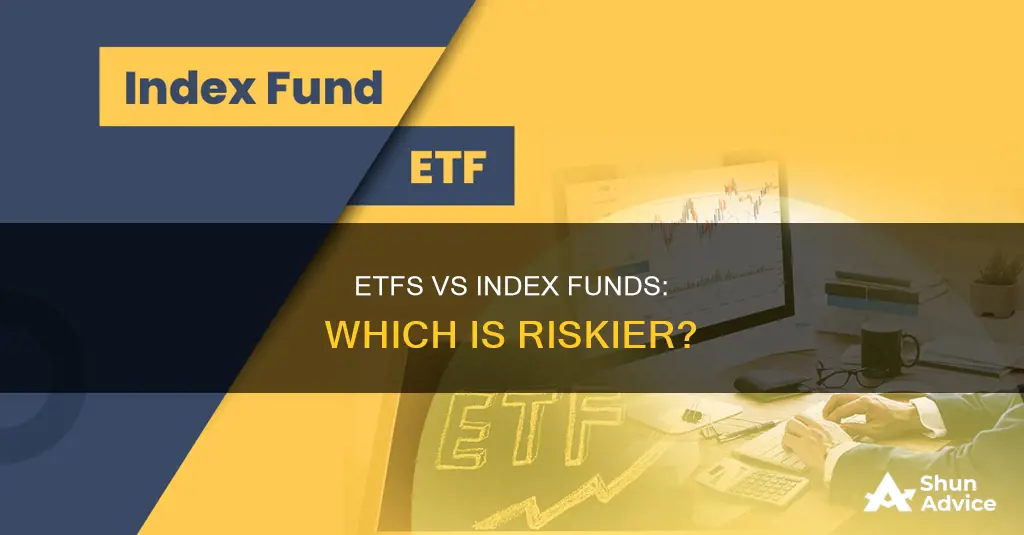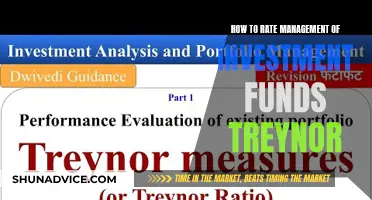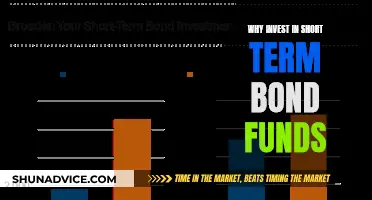
Exchange-traded funds (ETFs) and index funds are both popular investment options, but they come with their own unique set of risks and benefits. So, which is the better option for investors?
ETFs are known for their flexibility and low costs. They can be traded throughout the day, like stocks, and often have lower minimum investment requirements than index funds. ETFs are also more tax-efficient, as they are structured to minimise capital gains distributions. However, investors need to be mindful of the trading fees that can accumulate with frequent ETF trades.
Index funds, on the other hand, offer broad diversification and are considered safer due to their passive management approach. By tracking a specific market index, these funds provide predictable returns and have lower expense ratios. However, they can only be bought and sold at the end of the trading day, based on the fund's net asset value.
While both options provide diversification and strong long-term returns, the choice between ETFs and index funds ultimately depends on the investor's goals, risk tolerance, and investment strategy.
| Characteristics | Values |
|---|---|
| Trading Mechanism | ETFs can be traded throughout the day like stocks; index funds can only be bought and sold at the end of the trading day. |
| Minimum Investment | ETFs have a lower minimum investment than index funds. |
| Capital Gains Taxes | ETFs are more tax-efficient than index funds. |
| Cost of Ownership | Both ETFs and index funds can be cheap to own, but ETFs may have lower expense ratios. |
| Liquidity | ETFs may be more liquid than index funds. |
| Diversification | Both ETFs and index funds can help investors create a well-diversified portfolio. |
| Management | Both ETFs and index funds are passively managed. |
| Returns | Both ETFs and index funds have strong long-term returns. |
What You'll Learn

ETFs can be more volatile than index funds
While exchange-traded funds (ETFs) are generally considered a safe investment, they can be more volatile than index funds. This is because ETFs trade like individual stocks, and their value can fluctuate throughout the trading day. Here are some key points to consider:
Underlying Fluctuations and Risks
ETFs offer diversification, but they are not immune to volatility. The potential for large swings depends on the scope of the fund. An ETF tracking a broad market index like the S&P 500 is likely to be less volatile than one tracking a specific industry or sector, such as oil services. It's crucial to understand the fund's focus and the types of investments it includes.
Liquidity Risk
Liquidity risk arises in ETFs when trading volumes are low, impacting bid-ask spreads. This can result in investors buying shares at a premium or selling at a discount, affecting overall returns. Niche or less-traded ETFs that track specific sectors or industries may have lower trading volumes, making it challenging to execute trades without affecting market prices.
Leveraged ETFs
Leveraged ETFs use debt to amplify returns, but they can be much riskier due to increased volatility. These funds aim to generate multiples of an index's returns, but their value can be extremely volatile as it constantly shifts with the underlying index. If the index loses value, leveraged ETFs can suffer significant losses.
Industry-Specific ETFs
Some ETFs are tied to specific industries or sectors, such as cryptocurrencies, which carry higher risks. These ETFs may hold riskier underlying assets, and investors may not be aware of all the securities in the fund.
Capital Gains Distributions
In some cases, ETFs distribute capital gains to shareholders, creating a tax liability. Investors may prefer the fund to retain and reinvest gains to avoid this tax burden. Additionally, reinvesting capital gains distributions incurs new fees.
Tracking Errors
Tracking errors refer to the deviation in performance between an ETF and its benchmark index. While generally small, larger tracking errors may indicate hidden risks in an ETF.
In summary, while ETFs offer benefits such as diversification and flexibility, they can also be more volatile than index funds due to various factors, including underlying fluctuations, liquidity risks, leverage, and industry-specific risks. Investors should carefully consider these factors and conduct thorough research before investing.
Mutual Funds in India: Best Time to Invest
You may want to see also

ETFs are traded like stocks, index funds are not
Exchange-traded funds (ETFs) are traded on stock exchanges, much like individual stocks. They offer investors a way to buy a basket of securities in a single transaction. ETFs can track various assets, including stocks, bonds, commodities, or currencies, and can be both actively and passively managed.
ETFs are priced throughout the trading day, with prices fluctuating constantly. They can be bought and sold like stocks, with prices based on supply and demand. This is in contrast to mutual funds, which are only priced at the end of the trading day, based on the fund's net asset value (NAV).
The ability to trade ETFs throughout the day provides greater liquidity compared to mutual funds. It also means that investors can take advantage of intraday price fluctuations, although this can encourage a mindset of active trading, which can add costs to a portfolio.
ETFs are known for having low expense ratios, but they do come with other fees to consider. Trading fees can quickly add up, especially for actively managed ETFs, and there may also be expense ratios to factor in.
While ETFs are diversified funds, they are not immune to volatility. The potential for large swings depends on the scope of the fund, with ETFs tracking specific industries or sectors generally being more volatile than those tracking broad market indexes.
In summary, ETFs are traded like stocks and offer benefits such as intraday trading, liquidity, and low expense ratios. However, they also come with their own set of risks and fees that investors should be aware of before investing.
Tracking Mutual Fund Investments: Strategies for Success
You may want to see also

ETFs can be more tax-efficient than index funds
Exchange-traded funds (ETFs) are often considered more tax-efficient than mutual funds. This is because ETFs are structured in a way that minimises taxes for the holder, resulting in a lower tax bill compared to a similarly structured mutual fund.
ETFs are taxed on dividends and capital gains distributions, as well as gains from market transactions. However, they are more tax-efficient than mutual funds for two main reasons. Firstly, ETFs have a unique mechanism for buying and selling. They use "creation units" that allow for the collective purchase and sale of assets in the fund. This means that ETFs usually don't generate the capital gains distributions that mutual funds do and, therefore, don't see the tax effects of those distributions. Secondly, most ETFs are passively managed, which creates fewer transactions because the portfolio only changes when there are changes to the underlying index it replicates. Actively managed funds, on the other hand, experience taxable events when selling the assets within them.
ETFs also tend to have low portfolio turnover, which can reduce the realised gains that need to be distributed. This often means a longer holding period for each of the underlying investments, which usually qualifies any gains that are realised for favourable long-term capital gains tax rates.
Additionally, when ETF investors sell their shares on the stock exchange to other investors, the ETF portfolio manager does not need to buy or sell any of the ETF's underlying investments. As such, one ETF investor's sell decision has no impact on other investors, helping to keep capital gains distributions low.
ETFs also have a unique creation and redemption mechanism, allowing authorised participants (APs) to build or disassemble baskets of ETF shares when demand increases or decreases, respectively. These primary market transactions are typically conducted in-kind, meaning securities are exchanged for ETF shares rather than cash. These in-kind transactions do not trigger a taxable event for the fund, further improving the tax efficiency of ETFs.
While both ETFs and mutual funds must distribute any capital gains to shareholders at the end of each year, decreasing their return on investment, ETFs generally distribute fewer capital gains. In 2023, just 2.5% of all ETFs distributed capital gains compared to 31.5% of mutual funds.
A Guide to Investing in Mutual Funds: Dodgx
You may want to see also

ETFs can have lower minimum investments
Exchange-traded funds (ETFs) are known for their low expense ratios and lack of minimum investment requirements. While ETFs do not have minimum investment sizes, the minimum amount an investor must pay to buy an ETF is the price of one share, plus any commissions and fees. This is in contrast to index funds, which often require shareholders to open an account with a minimum investment. For example, many Vanguard index funds have a minimum investment of $3,000.
ETFs are therefore more accessible to investors who want to start investing with a small amount of money. They are also more flexible, as investors can buy as little as one share. This makes ETFs a good option for those who invest smaller amounts regularly, such as each month or with every paycheck.
However, it is worth noting that while ETFs may have lower expense ratios than mutual funds, buying and selling them could incur trading fees depending on your brokerage. In contrast, many index mutual funds can be bought directly from the issuer without commissions.
ETFs are also more tax-efficient than index funds. Investors in ETFs do not incur any capital gains until they sell shares in the fund and are liable for taxes if the selling price is higher than the purchase price. With ETFs, investors can control when they incur a taxable event.
Mutual Funds and Bonds: A Beginner's Guide to Investing
You may want to see also

ETFs can be more expensive to trade than index funds
While ETFs and index funds are both considered low-cost investment options, the way they are traded can make a difference in the costs incurred by investors.
ETFs are bought and sold on exchanges like stocks, and investors usually have to pay a commission to their broker each time they trade. These trading fees can quickly add up, especially for active traders, reducing the overall performance of their investments. Some brokers may offer commission-free trading, but there could still be hidden costs in the form of payment for order flow (PFOF), where trades are routed to a specific counterparty instead of going through the market to get the best price.
On the other hand, index funds are typically bought and sold directly from the fund company or manager at the end of the trading day, based on the fund's net asset value (NAV). There are generally no shareholder transaction costs for mutual funds like index funds, and they can often be purchased directly from the issuer without commissions.
Another cost to consider when investing in ETFs is the bid-ask spread, which is the difference between the buying and selling prices. While this cost is usually small for high-volume, broad-market ETFs, it is an additional expense that investors incur when buying ETFs.
It's important to note that the expense ratios of ETFs and index funds, which represent the ongoing management fees, are generally low for both types of investments. However, ETFs may have a slight advantage when it comes to expense ratios, especially for niche indexes.
Mutual Fund Investment: Tracking and Monitoring Basics
You may want to see also
Frequently asked questions
While all investments carry risk, ETFs can be safer than stocks if you're truly interested in diversified, "buy and hold" investing over the long term. ETFs are comprised of many components that allow for built-in diversification. However, a few ETFs exist that are not only imperfect ways to follow this advice but are actually the polar opposite of this strategy, such as leveraged ETFs.
ETFs carry some unique risks. For example, investors can buy and sell ETFs during market hours, and every time you buy or sell, you might pay a commission. This trading fee can quickly add up and reduce your investment's performance. Each ETF will also come with an expense ratio, which measures what percentage of a fund's total assets are required to cover operating expenses each year. The higher the expense ratio, the lower the total returns will be for investors.
Index funds will fall in value when their target index declines, and they may underperform actively managed funds during certain market conditions. Not all indexes are created equal, and some may be more representative of their target market than others.
The biggest difference is that ETFs can be traded throughout the day like stocks, whereas index funds can be bought and sold only for the price set at the end of the trading day. ETFs will also usually have a lower minimum investment than index funds, and they are more tax-efficient.







